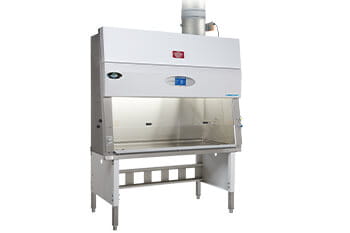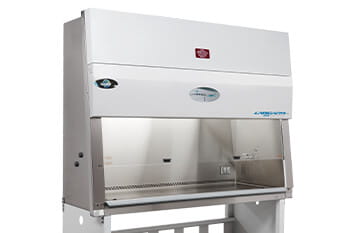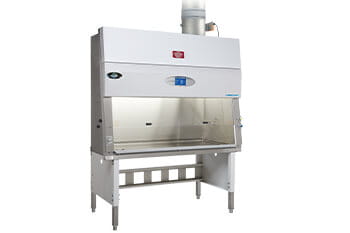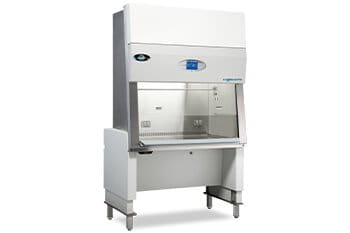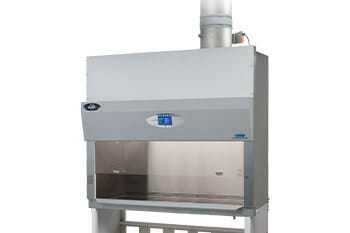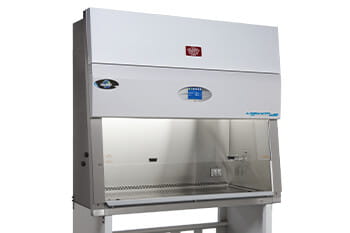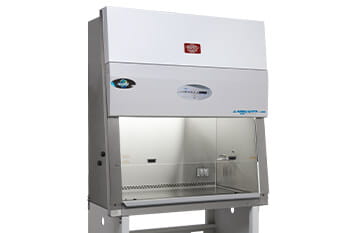Article
Fume Hood vs Biosafety Cabinet
2/3/2023Fume hoods and biosafety cabinets are two types of laboratory equipment designed to protect laboratory workers from hazardous materials. These types of equipment have different designs, functions, and levels of protection, and it is essential to understand the difference between them.
Fume Hoods
A fume hood is a ventilation system that protects laboratory workers from toxic fumes, vapors, and dust generated by laboratory experiments or procedures. Fume hoods are designed to draw air containing hazardous materials away from the laboratory worker and into the hood, where it is filtered or exhausted to the outside. The basic principle behind a chemical fume hood is to contain and remove hazardous fumes generated within the hood by drawing them away from the user and into the exhaust system. The hoods are usually made of steel or chemical-resistant polypropylene and have a sash that can be adjusted to control airflow into the hood. Fume hoods do not contain HEPA filters or a motor/blower.
When a chemical fume hood operates, the air is drawn into the hood from the laboratory through the sash opening. The hazardous fumes are contained within the hood, and the air is exhausted to the outside through a duct system connected to the hood. The airflow within the hood creates a barrier between the user and the hazardous fumes, providing protection against inhalation exposure.
ANSI/ASHRAE 110-2016
ANSI/ASHRAE Standard 110-2016 offers a comprehensive method of testing the performance of laboratory fume hoods. The standard applies to conventional, bypass, auxiliary air, and variable-air-volume (VAV) laboratory fume hoods and is intended primarily for laboratory and factory testing.
The purpose of this standard is to provide a quantitative and qualitative method for evaluating the fume containment of laboratory fume hoods. The test method considers the various factors that influence the performance of laboratory fume hoods, including the hood's aerodynamic design, the operation method, the stability of the exhaust ventilation system, the supply ventilation of the laboratory room, and the work practices of the user. The standard provides a reproducible method of testing laboratory hoods and gives a performance rating, including the influences of the laboratory arrangement and its ventilation system.
The desired hood performance should be defined through the cooperative efforts of the user, the chemical hygiene officer, the applications engineer, and other parties affected by the hood performance. The test method is a performance test and does not prescribe how much airflow should be present but specifies how the airflow should be measured.
Biosafety Cabinets
On the other hand, a biosafety cabinet is a type of enclosed laboratory equipment designed to protect from hazardous biological materials. Biosafety cabinets are used in laboratory settings where hazardous microorganisms, such as viruses and bacteria, are handled. The cabinets are designed to create a barrier between the laboratory worker and the hazardous material and to prevent the release of hazardous biological materials into the environment. Biosafety Cabinets are broken down into three different classes offering different levels of biological protection.
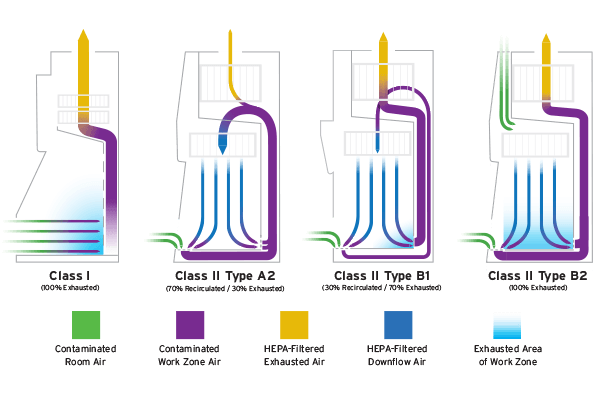
Class I Biosafety Cabinets
Class I BSCs provide personnel protection and environmental protection but no product protection. The Class I BSCs are typically used for cage dumping, culture aeration, tissue homogenization, or to enclose equipment such as centrifuges, harvesting equipment, or small fermenters, where aerosols may be generated but product protection is not required.
The Class I BSC operates by drawing unfiltered room air through the work opening and the work surface. The airflow is maintained at a minimum inward velocity of 75 linear feet per minute (lfm) through the front opening to ensure personnel protection. The air is then drawn into an exhaust plenum that contains a HEPA filter, which filters out any aerosols and particulates protecting the environment.
Class II Biosafety Cabinets
A Class II Biosafety Cabinet (BSC) is a type of laboratory equipment designed to protect laboratory workers, the environment, and the product being handled. It is used for work involving microorganisms assigned to Risk Groups (RG) 1-4. The Class II BSC operates based on the laminar flow principle and uses HEPA filters to capture and remove airborne contaminants from the air stream.
There are five types of Class II BSCs: A1, A2, B1, B2, and C1. Every kind of BSC provides personnel, environmental, and product protection but handles how the air is used within the system differently.
The Type A1, A2, and C1 BSCs have internal fans that draw air into the cabinet's front grille, creating personnel protection. In addition, the downward flow of HEPA-filtered air provides product protection by minimizing the chance of cross-contamination across the work surface. The exhaust air from these cabinets is passed through a HEPA filter and can be recirculated to the laboratory or exhausted outside the building through a canopy connection.
The Type B1 and B2 BSCs are direct-connected to the building exhaust system. A pressure-independent monitor and alarm must be installed to warn and shut off the BSC supply fan if there is a failure in exhaust airflow. The exhaust blower should be connected to the emergency power supply to maintain critical operations.
HEPA filters effectively trap particulates and infectious agents but does not capture volatile chemicals or gases. Therefore, only canopy-connected Types A1, A2, and C1, or hard-connected Types B1 and B2 BSCs should be used when working with small amounts of volatile, toxic chemicals.
Class III Biosafety Cabinets
The Class III BSC offers maximum protection against highly infectious microbiological agents and hazardous operations. A Class III BSC is a gas-tight enclosure with a non-opening view window and is equipped with a dunk tank or a double-door pass-through box for the passage of materials. This setup ensures the safety of the environment and the worker by preventing the release of hazardous materials into the surrounding area.
Supply and exhaust air is filtered by High-Efficiency Particulate Air (HEPA) filters, with exhaust air passing through two HEPA filters or a HEPA filter and an air incinerator before being discharged directly to the outdoors. The Class III BSC operates under negative pressure, which is maintained by an exhaust system exterior to the cabinet. This negative pressure ensures that if a breach occurs, the containment performance remains uncompromised, and the risk of exposure to hazardous materials is minimized.
Long, heavy-duty rubber gloves are attached to the cabinet in a gas-tight manner, allowing direct manipulation of materials isolated inside. This design ensures that the user's direct contact with hazardous materials is prevented while still allowing access. Although the gloves may restrict movement, the trade-off is on maximizing personal safety.
NSF/ANSI 49
NSF/ANSI 49: Design, Construction, Performance, and Field Certification of Biosafety Cabinetry is a comprehensive standard that dictates the specifics of design, construction, and performance of Class II (laminar flow) biosafety cabinets. The ultimate objective of this standard is to ensure that biosafety cabinets offer effective personnel, product, and environmental protection, demonstrate durability and reliability, and can be efficiently cleaned and decontaminated.
The standard elucidates numerous tests that the biosafety cabinets must successfully pass to meet the standard. Tests encompass basic necessities like durability, structural stability, cleanability, noise level, illumination, vibration, and motor/blower performance. Alongside these, the standard also emphasizes biological testing to ascertain the effectiveness of the cabinet in preventing contamination and ensuring user safety. This encompasses air containment and product protection tests, with rigorous procedures to verify that the cabinet maintains a sterile work environment and prevents exposure to potentially hazardous materials.
Cabinets that pass these collective tests are considered to have met the minimum requirements outlined in the standard. Variations in design and construction may still qualify under the standard, provided that appropriate tests and investigations indicate that the biosafety cabinet is durable, reliable, can be cleaned and decontaminated, and performs in accordance with the standard, including the imperative biological safety considerations.
Conclusion
Fume hoods and biosafety cabinets are designed to protect laboratory workers from hazardous materials. However, the type of protection provided by each is different. Fume hoods protect laboratory workers from inhaling toxic fumes and vapors from laboratory experiments or procedures. In contrast, biosafety cabinets are designed to protect laboratory workers from hazardous biological materials. Therefore, it is essential to choose the right type of equipment for a specific laboratory application to ensure the safety of the laboratory workers and the environment.

